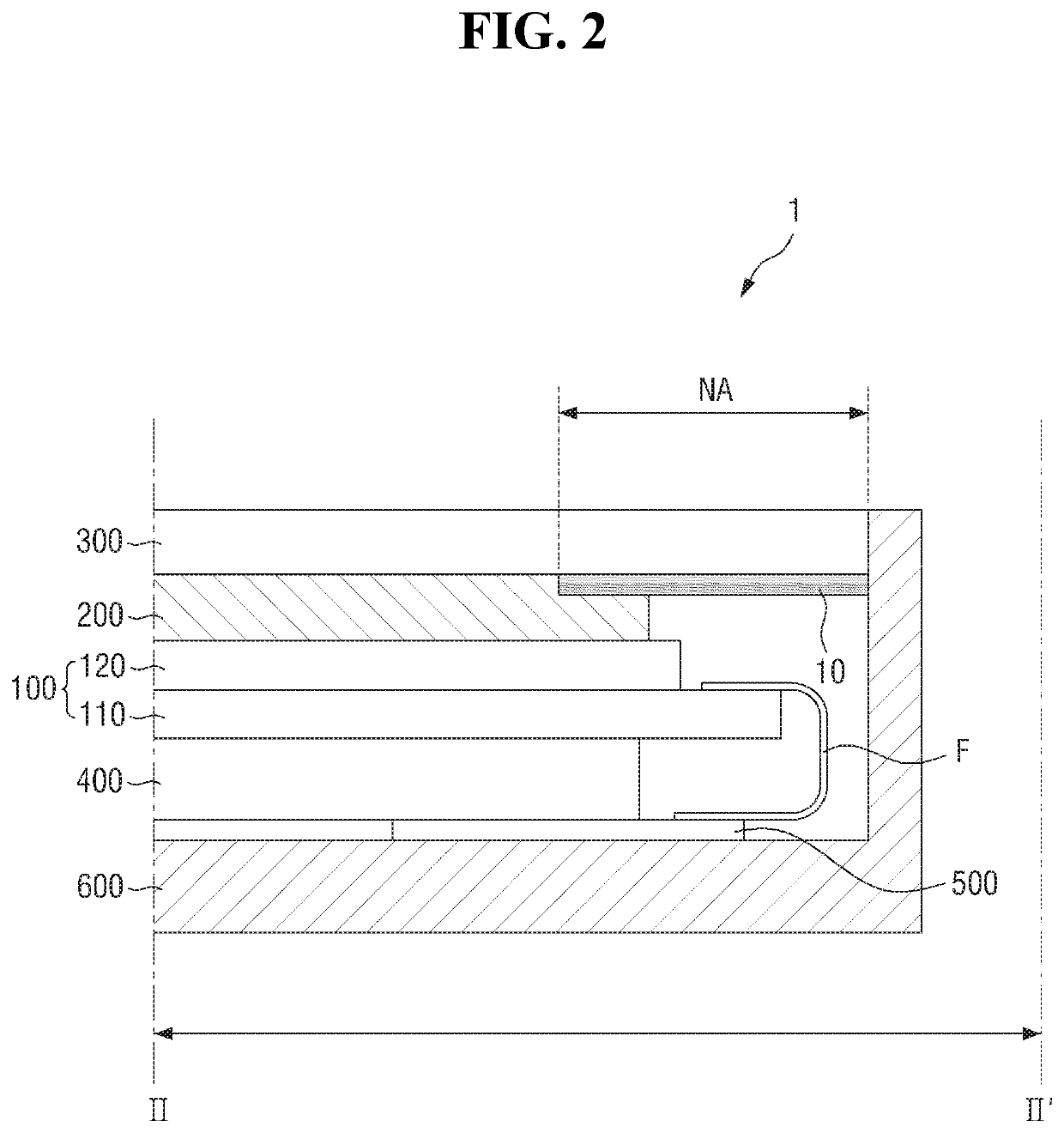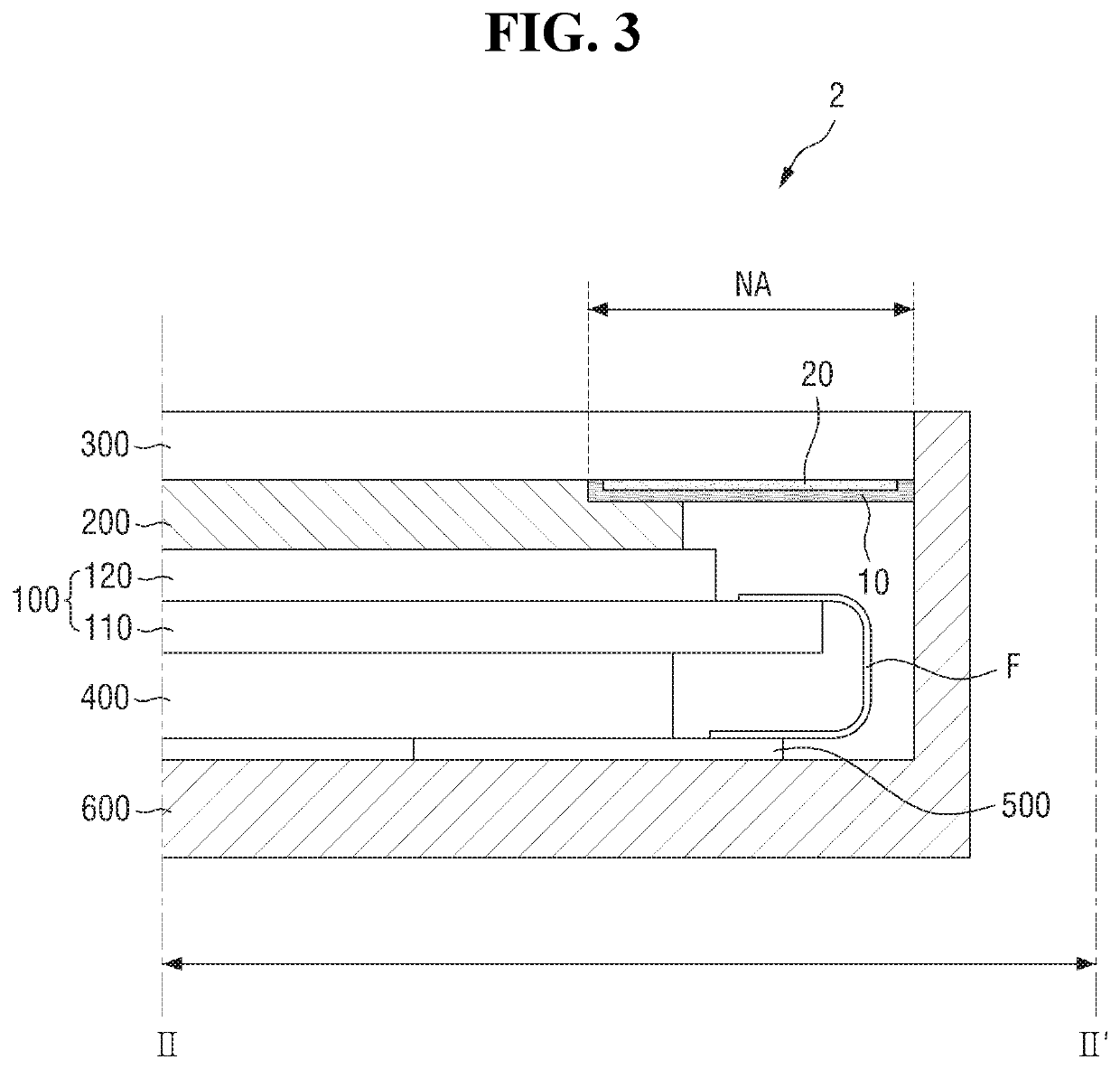Ink blocking layer for display device and manufacturing method thereof
a technology of display device and blocking layer, which is applied in the direction of display/control unit casings, instruments, casings of electrical apparatus, etc., can solve the problems of high fluidity and permeability, difficulty in appropriately adjusting (e.g., controlling) the amount of curable resin, and overflow of curable resin
- Summary
- Abstract
- Description
- Claims
- Application Information
AI Technical Summary
Benefits of technology
Problems solved by technology
Method used
Image
Examples
preparation example
[0109]300 g of ethyl acetate as a solvent was put into a 2 L reactor, and heated to 80° C. with stirring to maintain a reflux state. Thereafter, 552 g (6.0 mol) of epichlorohydrin was slowly added, and then stirring was performed for 4 hours until epichlorohydrin was completely dissolved in the solvent. Thereafter, 0.3 g (300 ppm) of sodium hydroxide (NaOH) was added and left for 30 minutes, and then 254 g (1.0 mol) of dipentaerithritol was slowly added and completely dissolved. In this state, the reaction was maintained for 6 hours or more, and the disappearance of hydroxyl groups (—OH) of dipentaerythritol was monitored through FT-IR. When it is determined through FT-IR that the hydroxyl groups have completely disappeared, the reaction product was slowly cooled (e.g., to room temperature), 500 ml of purified water was added and stirred, and then the water was removed by a separatory funnel. This washing process was repeated three to four times. After confirming that the pH of acid...
experimental example 1
ion Prevention Ability
[0115]An ink blocking layer was formed on a reinforced glass in the same manner as in Preparation Example. Specifically, a first layer having a thickness of 5 μm was formed on the reinforced glass with the above-mentioned mixed composition and cured at 150° C. for 30 minutes, and then a second layer having a thickness of 5 μm was formed thereon and finally cured at 150° C. for 30 minutes to form an ink blocking layer, thereby preparing a single printing structure (i.e., a structure with only the ink blocking layer on the reinforced glass).
[0116]Further, an acrylic resin / urethane curing ink (white) is first printed on the reinforced glass, and then the same ink blocking layer as Preparation Example is formed thereon, thereby preparing a ground color ink layer mixing structure (i.e., a structure including both the ground color ink layer and the ink blocking layer on the reinforced glass).
[0117]In order to evaluate the penetration prevention ability of these struc...
experimental example 2
of Increasing Penetration Ability by Acid
[0120]Two kinds of curing agents were prepared in the same manner as in Preparation Example, except that whether each of the curing agents contains an acrylic acid resin was changed as given in Table 3 below.
[0121]
TABLE 3Curing agent 1Curing agent 2ComponentEDAAcrylic acid resin + EDA(weight ratio 5:1)Ratio4 wt % to main material10 wt % to main materialAdditive amount of10 wt %7 wt %solvent
[0122]The two kinds of curing agents were mixed with the main material. The penetration prevention ability of each of the cured ink blocking layers was evaluated in the same manner as in Experimental Example 1 depending on the curing conditions given in Table 4 below, and the evaluation results thereof are given in Table 4.
[0123]
TABLE 4Ink blocking layer 1Ink blocking layer 2Curing conditions(curing agent 1 utilized)(curing agent 2 utilized)120° C., 20 minutesPenetration occurredPenetration did not occur130° C., 20 minutesPenetration occurredPenetration did...
PUM
| Property | Measurement | Unit |
|---|---|---|
| temperature | aaaaa | aaaaa |
| area DA | aaaaa | aaaaa |
| DA | aaaaa | aaaaa |
Abstract
Description
Claims
Application Information
 Login to View More
Login to View More - R&D
- Intellectual Property
- Life Sciences
- Materials
- Tech Scout
- Unparalleled Data Quality
- Higher Quality Content
- 60% Fewer Hallucinations
Browse by: Latest US Patents, China's latest patents, Technical Efficacy Thesaurus, Application Domain, Technology Topic, Popular Technical Reports.
© 2025 PatSnap. All rights reserved.Legal|Privacy policy|Modern Slavery Act Transparency Statement|Sitemap|About US| Contact US: help@patsnap.com



